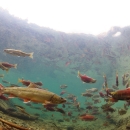We completed a multi-year synthesis of the data and analyses for the Walla Walla River
to help broadly prioritize conservation actions and inform the conservation of bull trout.
• The assessment provides fundamental and critical information on bull trout growth,
movement patterns, and survival rates. At the population level we assess abundance,
structure structure
Something temporarily or permanently constructed, built, or placed; and constructed of natural or manufactured parts including, but not limited to, a building, shed, cabin, porch, bridge, walkway, stair steps, sign, landing, platform, dock, rack, fence, telecommunication device, antennae, fish cleaning table, satellite dish/mount, or well head.
Learn more about structure , and growth rate. We characterized habitat quality, suitability, and availability
for the Walla Walla River and Mill Creek that was formerly lacking.
• Protection of South Fork Walla Walla River spawning and rearing habitats and
improvement of the lower Walla Walla River migratory and foraging corridor will allow
bull trout to complete their lifecycle, express life-history variability, potentially serving as
a donor population for other local populations (e.g., Touchet River and Mill Creek
populations), or core areas (e.g., Umatilla Core Area) in less desirable habitat, and
improve the resiliency of the entire Walla Walla River Core Area.
• Walla Walla River migratory fish appear to reach larger sizes and approach their maxima
faster than do residents (i.e., migrants exhibit faster growth rates), although considerable
overlap between the two life-history expressions appears to occur. Growth at juvenile
life stages before emigration may be slightly higher for migratory fish than for resident
fish.
• Generally, fish that migrated as sub-adults and small adults moved farther downstream
and remained in lower parts of the watershed longer than juveniles and large adults. It
appears that environmental factors and/or individual intrinsic growth influence transition
to a migratory life-history. The consequences of the migratory life-history expression
appear to involve complex tradeoffs between the benefits of increased growth and
fecundity, but at a cost of lower survival.
• Larger bull trout size classes showed the greatest tendency to migrate downstream out
of the headwater area. Since the lower river demonstrates a longitudinal trajectory of
habitat degradation, migratory bull trout in the sub-adult and small adult size classes
may be the most susceptible to lower river mainstem mortality. If this is the case,
reduced survival for the sub-adult and small adult size categories could reduce the
potential reproductive contribution of the migratory component of the population and the
opportunity for dispersal.
• Several lines of evidence demonstrate that bull trout in the Walla Walla River Core Area
still attempt to disperse among the local populations and between core areas (e.g.,
genetic and movement data). Providing for dispersal, by improving habitat conditions
that restore connectivity among local populations and between core areas, is vital to
maintaining and enhancing viability of the Walla Walla River Core Area local populations
of bull trout and could be vital to long term maintenance of adjacent core area
populations
Courtney Newlon
Darren Gallion
Don Anglin
Howard Schaller
Mary Connor
Phaedra Budy
Robert Al-Chokhachy
Tracy Bowerman
Publication date
Type of document
Report
Facility
Program
Species
FWS Focus
Ecosystem
FWS and DOI Region(s)







